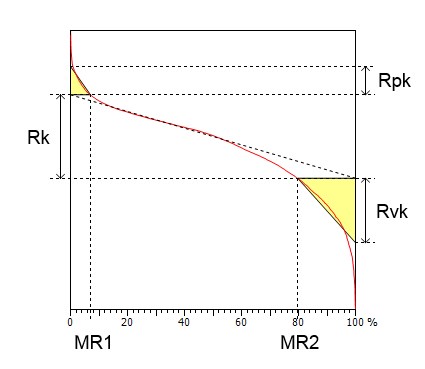Functional Parameters from ISO 13565
This series of standards are specially aimed at characterizing stratified surface texture produced by a two-step manufacturing process such as honing-polishing machining. The first part of this standard series, ISO 13565-1, defines a special double-pass filter that provides a sort of robustness against deep holes that are common in stratified surfaces. This filter is now superceded by the Gaussian Regression filter defined in ISO 16610-31. Part 2 defines a set of parameters called Rk parameters that are derived from a graphical construction on the Abbott-Firestone curve. Rk parameters should be calculated only if the Abbott curve has a S-shape, otherwise the graphical construction may fail and parameter values will be meaningless.

Graphical construction of Rk parameters
1. Parameters of ISO 13565-2
Rk, core roughness depth
Rpk, reduced peak height. This parameter is used to characterize protruding peaks that might be eliminated during function.
Rvk, reduced valley depth. This parameters is used to characterize valleys that will retain lubricant or worn-out materials.
MR1 and MR2: material ratio delimiting the core area.
Other parameters such as A1 and A2, Rpk* or Rvk* can also be calculated for specific use.
2. Parameters of ISO 13565-3
This standard is specilized in the characterisation of stratified vertical random components such as a valley texture with a fine plateau texture superimposed. Here again, these parameters should be calculated only on surfaces that comply with this description.
Rpq, Plateau Root Mean Square roughness
Rvq, Valley Root Mean Square roughness
Rmq, Material ratio at plateau-to-valley transition
These parameters can be also calculated on the primary profile, as Ppq, Pvq and Pmq.
These parameters are part of the Automotive module in MountainsMap®.
Since the publication of ISO 21920-2, ISO 13565-2 and ISO 13565-3 standards were withdrawn. New drawings and surface texture tolerances are supposed to use the new standard now.